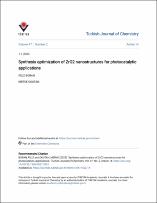| dc.contributor.author | Boran, Filiz | |
| dc.contributor.author | Okutan, Merve | |
| dc.date.accessioned | 2023-11-21T10:53:48Z | |
| dc.date.available | 2023-11-21T10:53:48Z | |
| dc.date.issued | 2023 | en_US |
| dc.identifier.citation | Boran, F., & Okutan M. (2023). Synthesis optimization of ZrO2 nanostructures for photocatalytic applications. Turkish Journal of Chemistry, 47(2), 448-464. | en_US |
| dc.identifier.issn | 1300-0527 | |
| dc.identifier.uri | https://doi.org/10.55730/1300-0527.3551 | |
| dc.identifier.uri | https://hdl.handle.net/11491/8693 | |
| dc.description.abstract | Abstract: This study aims to optimize the synthesis of semiconductor zirconia (ZrO2 ) nanoparticles for future photocatalytic applications in degradation of pollutants in wastewater under ultraviolet (UV) light. The synthesis procedure of ZrO2 nanoparticles was optimized by examining the effects of synthesis methods (ultrasound-assisted, hydrothermal method in an autoclave and conventional precipitation), reaction time (2, 6, 10, and 18 h), ambient pH (3, 7, 10, 13), and surfactant type (anionic, cationic, and non-ionic), on the particle size and crystal phase of the nanomaterial. The characterization of the synthesized samples was performed by X-ray diffraction (XRD), Fourier transform infrared spectroscopy (FTIR), energy-dispersive X-ray spectroscopy (EDS), high-contrast transmission electron microscopy (HR-TEM), and transmission electron microscope (TEM) analysis. Consequently, to synthesize ZrO2 nanoparticles with the smallest particle size and monoclinic/tetragonal phase, the experimental conditions were optimized as ultrasound-assisted synthesis method, pH 10, and 6 h reaction time without surfactant. Moreover, percentage yield, particle size, crystallinity, monoclinic and tetragonal volumes of ZrO2 nanostructures synthesized under optimized conditions were determined as 39.40%, approximately 9 nm, 46.77, 79%, and 21%, respectively. It has been determined that the particle sizes can be kept under control by controlling the phase composition of ZrO2 nanostructures by optimizing the synthesis parameters. Structural and morphological characterization results can be correlated to the photocatalytic application, showing the potential of this material for the photodegradation of organic dye pollutants. | en_US |
| dc.language.iso | eng | en_US |
| dc.publisher | Scientific and Technological Research Council Turkey | en_US |
| dc.relation.ispartof | TURKISH JOURNAL OF CHEMISTRY | en_US |
| dc.rights | info:eu-repo/semantics/openAccess | en_US |
| dc.subject | Zirconia | en_US |
| dc.subject | Photocatalytic application | en_US |
| dc.subject | Synthesis optimization | en_US |
| dc.subject | Particle size | en_US |
| dc.subject | Crystal phase | en_US |
| dc.title | Synthesis optimization of ZrO2 nanostructures for photocatalytic applications | en_US |
| dc.type | article | en_US |
| dc.department | Hitit Üniversitesi, Mühendislik Fakültesi, Kimya Mühendisliği Bölümü | en_US |
| dc.authorid | 0000-0002-4315-9949 | en_US |
| dc.authorid | 0000-0002-3110-0675 | en_US |
| dc.identifier.volume | 47 | en_US |
| dc.identifier.startpage | 448 | en_US |
| dc.identifier.endpage | 464 | en_US |
| dc.relation.publicationcategory | Makale - Ulusal Hakemli Dergi - Kurum Öğretim Elemanı | en_US |
| dc.contributor.institutionauthor | Boran, Filiz | |
| dc.contributor.institutionauthor | Okutan, Merve | |
| dc.identifier.doi | 10.55730/1300-0527.3551 | en_US |
| dc.description.wosquality | Q4 | en_US |
| dc.description.wospublicationid | WOS:000996094100013 | en_US |
| dc.description.pubmedpublicationid | 37528935 | en_US |


















